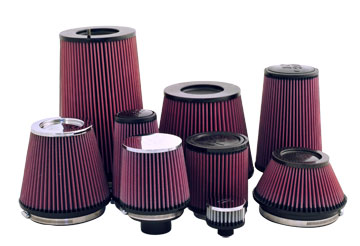OK you need more convincing .
Before spending your money on an aftermarket intake, let's debunk the misleading incomplete info about filtering and horsepower in the sales literature.

www.nicoclub.com
.. "which investigated the high failure rates of modern MAF sensors. Several factors where involved which revealed what many have suspected all along.
Higher air flow capability with the K&N is the result of larger pores in the filter media to offset the smaller total area when compared to any OEM filter. Oil is used to help trap the dirt when it comes in contact with the filter media. One of the aspects of this design allows what is referred to as "Tracking" where certain regions of the filter media as a result of internal air box flow patterns directs particles to specific regions of the filter more than others. What occurs next is those regions lose the oil saturation to the increased dirt loading allowing particles in the 90 micron range to pass through the media since there is no longer any more residual oil in the local pores.
Oil migration. Oil migration occurs when the motor is in warm climates and/or operating at high engine speeds where the volume of air passing accross the filter carries small amounts of oil into the air stream post filter which is now entering the motor.
Particles less than 90 microns... Pull a hair out of your head and push it through the filter media, if it passes through you have a filter with pores GREATER than 100 Microns in size! This is the primary issue with MAF sensors. MAF sensors rely on filtration quality that captures 95% of all particles greater in size than 15 microns. Ideally 10 micron capability would result in longer life but now the physical size of the filter is increased to offset the fine fitlering capability when using conventional or synthetic fibers in an "Un-Oiled" air filter.


MAF air flow sensor design. MAF sensors use micrscopic heating elements placed on a circuit board. The heating element provides a constant rise in temperature to provide a known condition for the ECU to calculate air flow. On the leading edge of the MAF sensor is a temperature sensor which measures the temperature of the air passing over the leading edge, this temperature returns a value to the ECU. As the air passes over the heated portion of the MAF sensor heat is transmitted to the air stream thus heating it. As the air passes accross the back portion of the sensor a second temperature reading is taken. Higher flow rates result in lower temperature rise, lower flow rates result in higher temperature rises.
Another aspect of the MAF sensor is static build up on the leading edge of the sensor element. This static charge causes small particles of dirt and debris to adhere to the elements leading edge distorting the laminar flow characteristics of the sensor throwing off the temeperature readings take accross the elements surface. Over time rotors form accross the back side of the build up depositing oil, dirt and anything else that is in the slip stream directly onto the heating elements surface. What happens next is that the oil/dirt or any combination of the two insulates the heating element causing it to overheat and short out. The result is a complete loss of data to the ECU causing it to revert to default values stored as a limp home function.
The precursor to the failure is often a reduction in peformance as a result of inaccurate thermal readings accross the sensor plate. As the dirt accumulates power typically drops off until the heating element fails.






OEM air filters believe it or not out perform K&N in all aspects. This is easily done by using filter media which has much smaller pore size (5 microns on "average") this allows typical filtration to hit the 10-15 micron range with the 95% effective range. However the fine filtration capabily results in more restriction, the restriction is offset by increasing the depth and number of the pleats the media uses. The biggest advantage to this is that the OEM filters are able to go 50,000-100,000 miles between changes WITHOUT resulting in any increases of restriction or worse yet ALLOWING MORE DIRT TO GET IN THE MOTOR! OEM filters REGARDLESS of miles or time in use perform as well or BETTER the more they are used again up until the reach the maximum restriction point (15" or 25" WC).
Most OEM air filters have anywhere between 1-4" water colum of restriction when new. A fitler is considered to be "Loaded" when restriction reaches 15" WC on naturally aspirated motors and 25"WC on turbo or supercharged vehicles. Regardless of how dirty the filter may look provided restriction does not exceed the above numbers the filter is providing 95% efficiency at removing all particles greater than 10-15 microns.
Bottom line is that using any type of high flow filter that does not meet the 95% filtering capability at 15 microns is asking for trouble.
Call K&N and ask them what their filtering efficiency is at 15 microns and if they will warranty the MAF if it becomes contaminated and burns out... I will save you the time, they will laugh at you and not do a thing."











